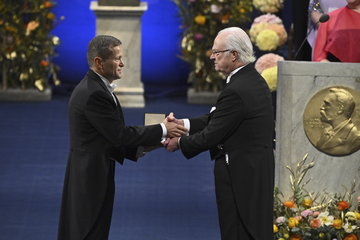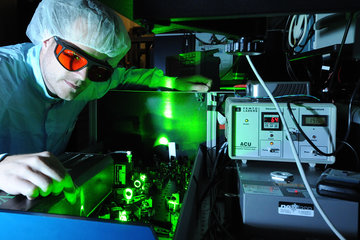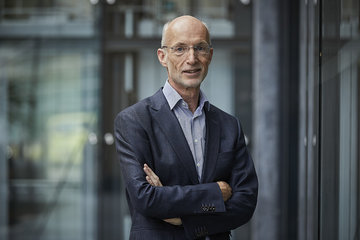Director in the attic
One hundred years ago Albert Einstein completed his general theory of relativity - a revolutionary description of gravitation as an inherent property of space and time. During this landmark phase of his life, Albert Einstein was supposed to take over as Director of the newly-founded Kaiser Wilhelm Institute for Physics. However, the plan was delayed by the outbreak of World War I.
Author: Thomas Bürke
On 25 November 1915, Albert Einstein held his seminal lecture before the Prussian Academy of Sciences in Berlin, which ended with the words: “Thus, the general theory of relativity as a logical edifice has finally been completed.” It was followed by days and weeks full of exuberant enthusiasm. Einstein remarked to friends that the theory is “of incomparable beauty” and that his wildest dreams had been fulfilled. He confided in the physicist Arnold Sommerfeld that it was “the most momentous discovery I’ve made in my life.”
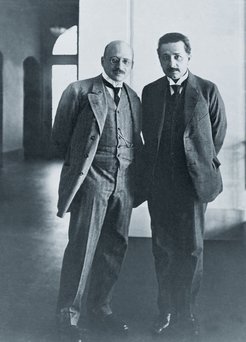
Two giants of science: Fritz Haber (left) and Albert Einstein in Berlin in 1914. Haber had advocated a physics institute within the Kaiser Wilhelm Society at an early stage. It was finally set up in 1917 – with Einstein serving as its Director.
His audience did not share this view. Even Max Planck and Max von Laue, who had always supported Einstein, remained sceptical. “A free, unprejudiced view is not at all a characteristic of (adult) Germans,” Einstein had written to his friend Michele Besso several years before. Was a new theory of gravitation really needed, given that Newtonian physics had served so well for a quarter of a millennium and appeared to explain everything?
Isaac Newton described gravity as action at a distance: two bodies, such as the earth and moon, are joined as if by invisible threads. However, the mechanism by which the force is transmitted was unclear. In addition, Newton’s formulas conveyed the impression that gravity reaches another body – no matter how distant –instantaneously, namely without any time lag. This was contradicted by Einstein’s 1905 special theory of relativity, according to which no physical effect can propagate faster than the speed of light.
Einstein’s description of gravity, known as physical gravitation, is entirely different. He concluded that gravity is a property of space and time. Matter bends space around it, and space forces matter to describe specific motions. The moon orbits the earth not because invisible lines of force connect the two bodies, but because the earth and the moon distort the fabric of space like steel balls on a rubber sheet, and they move around each other within the resulting distortions.
Gravity is a property of space and time or, more precisely, space-time geometry. In this respect, it is unique. All other forces of nature act within space and time. Gravitation is space and time. Max von Laue, who was initially sceptical, later wrote that curved space “is by no means a mathematical construct but a reality that is inherent in all physical processes. This discovery is Albert Einstein’s greatest achievement.”
The process of discovery was nearly as astonishing as the result itself. Einstein developed his theory of gravitation almost single-handedly. Only once did he need the help of his friend Marcel Grossmann, when he was unable to find his way through the mathematical thicket. Luckily, Grossmann surmised what Einstein needed: the mathematics of curved space, which Bernhard Riemann had developed in the mid-19th century.
In the mid-1990s, Jürgen Renn and Tilman Sauer of the Max Planck Institute for the History of Science in Berlin together with colleagues from the USA traced Einstein’s convoluted process of trial and error. Their work was based on notes that Einstein had kept in Zurich between the summer of 1912 and the spring of 1913. The notes showed that Einstein had already found the correct field equations towards the end of 1912 - but erroneously discarded them. He did so because of his stipulation that the new theory must contain Newton’s formulas as a limit for very weak gravitation. In determining this limit, Einstein made a simple mathematical error, which he did not discover until 1915.
As early as July 1913, Max Planck and Walther Nernst asked Einstein, who at the time was a professor for theoretical physics at ETH Zurich, whether he would be interested in taking up a post at the Prussian Academy of Sciences. He was also slated to become the Director of the Kaiser Wilhelm Society, which was being set up at the time. Einstein agreed, as he was attracted by the prospect of a research post without teaching obligations. Another major factor in his decision was the possibility of living near his cousin Elsa, whom he had fallen in love with during an earlier visit to Berlin.
His colleagues hoped that Einstein would give fresh impetus to quantum theory, which promised great opportunities for scientific and technical progress. However, Einstein let it be known that he was not at all sure whether he would be able to “lay a golden egg” in this field. Above all, he did not want to focus on quantum physics at all, and his colleagues soon realized this: “Einstein is evidently so engrossed in gravitation that he’s deaf to everything else,” the mathematician David Hilbert once noted with resignation.
The Kaiser Wilhelm Society had been founded just a short time before in June 1911. The aim of its institutes was to pursue research exclusively, and they were generously funded – among others by donors such as entrepreneurs and financiers. The institutes included the Institute for Physical Chemistry and Electrochemistry and the Institute for Chemistry, both in Dahlem. The time was ripe to set up a physics institute as well.
Luminaries such as Fritz Haber, Walther Nernst and Max Planck advocated such an institute, and on 21 March 1914, the Senate of the Kaiser Wilhelm Society resolved to found one. Their decision was greatly facilitated by a promise from the banker and industrialist Leopold Koppel to provide the building and to assume one-third of the costs. Another third would be provided by the Prussian government.
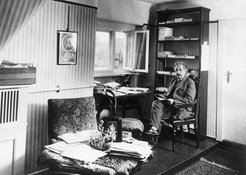
Director in the attic: Albert Einstein headed the Kaiser Wilhelm Institute for Physics from 1917 to 1922. His daily trip to work was not a long one - the Institute was housed in Einstein’s flat in Schöneberg.
But not long afterwards, the plans were scrapped: On 31 July 1914, the Ministry of Finance rejected any further funding. The next day, World War I broke out, and the project was put on hold. Albert Einstein nevertheless travelled to Berlin: “At Easter I’m travelling to Berlin as an academic individual without any obligation, as a living mummy, so to speak. I’m looking forward to this trying profession!” he wrote to his friend and colleague Jakob Laub.
A stroke of luck then occurred which led to the foundation of the Kaiser Wilhelm Institute for Physics on 1 October 1917, when the Berlin-based industrialist Franz Stock offered a donation of 540,000 marks. However, Einstein did not move into a grand building but resided in his flat at Haberlandstrasse 5 in Schöneberg, where he lived across from his cousin Elsa.
The organization of this institute differed considerably from that of any other Kaiser Wilhelm Institute. It was managed by two boards: a six-strong Board of Trustees and a Board of Directors, of which Einstein was a member. However, Einstein tried to reduce meetings to a minimum. During his term of office from 1917 to 1922, the Board of Directors met only 11 times.
Unlike other institutes, the annual budget was to be used mainly to fund research projects at other institutes in as many fields of physics as possible. It was hoped that Einstein would give fresh impetus to the solution of theoretical questions, but he was unhappy with this arrangement. Einstein had little financial freedom, and the Board of Directors was not willing to support projects to test general relativity.
Overall, around three-quarters of the projects funded by the Kaiser Wilhelm Institute for Physics in the period from 1918 to 1922 dealt with the refinement of quantum theory in some form. “It’s clear that the KWI for Physics made important contributions to advances in physics,” concludes Giuseppe Castagnetti of the Max Planck Institute for the History of Science, who chronicled the history of the KWI for Physics several years ago.
Ultimately, Albert Einstein was not the right person to head such an institute. He had no interest in launching new projects and bringing together scientists to carry them out. He therefore stepped down as Director of the Institute in 1922, and the post passed on to Max von Laue. Just a few months later, the former “Institute Director without an institute building” was awarded the Nobel Prize for Physics.



